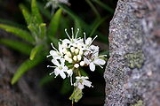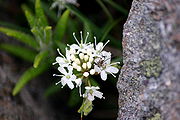
Labrador tea
Encyclopedia
Labrador tea is a name commonly applied to three closely related species:
In Labrador
itself, Labrador Tea is also frequently called Indian Tea.
All three are primarily wetland plants in the Heath family (Ericaceae
) with strongly aromatic leaves that can be used to make a very palatable herbal tea. Labrador tea has been a favorite beverage among Athabaskan and Inuit
people for many years.

The Pomo, Kashaya
, Tolowa
and Yurok of Northern California boiled the leaves of Western Labrador Tea similarly, to make a medicinal tea.
In medieval Northern Europe
, R. groenlandicum and R. tomentosum were often brewed in "gruit
" ales, prior to the adoption of hops
.
Labrador tea contains ledol, a poisonous substance that can cause cramps and paralysis.
Rhododendron groenlandicum grows in bogs and wet shores, and sometimes on rocky alpine slopes. Both species are generally northern (north temperate to tundra) in distribution, with the range of R. groenlandicum somewhat farther south.
Rhododendron neoglandulosum grows in wetlands and bogs in western North America, from British Columbia to California to Colorado.
- Rhododendron tomentosum (Northern Labrador Tea, previously Ledum palustre),
- Rhododendron groenlandicum, (Bog Labrador Tea, previously Ledum groenlandicum or Ledum latifolium) and
- Rhododendron neoglandulosumRhododendron neoglandulosumRhododendron neoglandulosum is a species of rhododendron known by the common names western Labrador tea and trapper's tea. It is a common shrub of western North America from British Columbia to California to Colorado, where it grows in moist areas such as bogs and marshes...
, (Western Labrador Tea, or Trapper's Tea, previously Ledum glandulosum).
In Labrador
Labrador
Labrador is the distinct, northerly region of the Canadian province of Newfoundland and Labrador. It comprises the mainland portion of the province, separated from the island of Newfoundland by the Strait of Belle Isle...
itself, Labrador Tea is also frequently called Indian Tea.
All three are primarily wetland plants in the Heath family (Ericaceae
Ericaceae
The Ericaceae, commonly known as the heath or heather family, is a group of mostly calcifuge flowering plants. The family is large, with roughly 4000 species spread across 126 genera, making it the 14th most speciose family of flowering plants...
) with strongly aromatic leaves that can be used to make a very palatable herbal tea. Labrador tea has been a favorite beverage among Athabaskan and Inuit
Inuit
The Inuit are a group of culturally similar indigenous peoples inhabiting the Arctic regions of Canada , Denmark , Russia and the United States . Inuit means “the people” in the Inuktitut language...
people for many years.

Description
All three species of Labrador tea are low, slow-growing shrubs with evergreen leaves. The leaves are smooth on top with often wrinkled edges, and fuzzy white to red-brown underneath. The tiny white flowers grow in hemispherical clusters and are very fragrant and sticky and highly attractive to bees.Uses
The Athabaskans brew the leaves as a beverage and some people chew the raw leaves because they enjoy the flavor. Others use Labrador tea to spice meat by boiling the leaves and branches in water and then soaking the meat in the tea.The Pomo, Kashaya
Kashaya
Kashaya has several meanings, see:* Kāṣāya, the traditional monastic robes of Buddhist monks and nuns.* Kashaya language, a distinct Pomo language on the Sonoma County Coastline, California* The subgroup of Pomo people who spoke this language...
, Tolowa
Tolowa
The Tolowa are a Native American tribe. They still reside in their traditional territories in northwestern California and southern Oregon. Tolowa are members of the federally recognized Smith River Rancheria, Elk Valley Rancheria, Confederated Tribes of Siletz, as well as the unrecognized Tolowa...
and Yurok of Northern California boiled the leaves of Western Labrador Tea similarly, to make a medicinal tea.
In medieval Northern Europe
Europe
Europe is, by convention, one of the world's seven continents. Comprising the westernmost peninsula of Eurasia, Europe is generally 'divided' from Asia to its east by the watershed divides of the Ural and Caucasus Mountains, the Ural River, the Caspian and Black Seas, and the waterways connecting...
, R. groenlandicum and R. tomentosum were often brewed in "gruit
Gruit
Gruit is an old-fashioned herb mixture used for bittering and flavoring beer, popular before the extensive use of hops. Gruit or grut ale may also refer to the beverage produced using gruit....
" ales, prior to the adoption of hops
Hops
Hops are the female flower clusters , of a hop species, Humulus lupulus. They are used primarily as a flavoring and stability agent in beer, to which they impart a bitter, tangy flavor, though hops are also used for various purposes in other beverages and herbal medicine...
.
Labrador tea contains ledol, a poisonous substance that can cause cramps and paralysis.
Habitat
Rhododendron tomentosum grows in peaty soils, shrubby areas, moss and lichen tundra.Rhododendron groenlandicum grows in bogs and wet shores, and sometimes on rocky alpine slopes. Both species are generally northern (north temperate to tundra) in distribution, with the range of R. groenlandicum somewhat farther south.
Rhododendron neoglandulosum grows in wetlands and bogs in western North America, from British Columbia to California to Colorado.
Harvesting
Rhododendron tomentosum, Rhododendron groenlandicum, and Rhododendron neoglandulosum grow slowly, so pick individual leaves rather than whole branches, and harvest from different shrubs. In addition, Labrador tea grows in abundance in large patches so it should not be difficult to move from plant to plant to avoid over-harvesting. Labrador tea is an evergreen plant and will be available all year long.External links and references
- Labrador Tea - US Forest Service
- Labrador Tea - A Modern Herbal (Grieves, 1931)
- Madawaska Valley Tea and Treats

